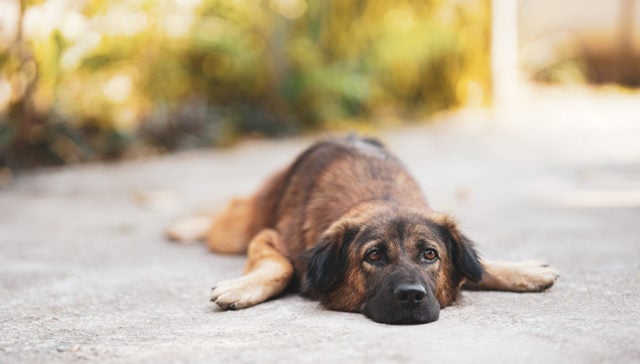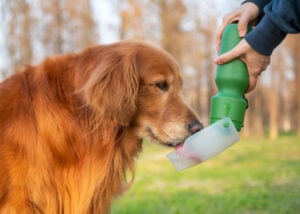
Table of Contents
Most dogs need 30 minutes to 2 hours of exercise per day. The exact time will depend on their age, breed, and any existing health conditions.
Daily physical activities are essential for our pets' physical, mental, and behavioral well-being, as well as for strengthening our bond and relationship with them.
But the question is, can you overexercise your dog?
What can possibly happen? And what are the signs that your dog is getting too much exercise?
Whether you have a high-energy Labrador Retriever or a laid-back Bulldog, it's crucial to understand the limits of healthy activity for your pup.
RELATED: Is Your Dog Getting Enough Exercise?
Signs Your Dog Is Getting Too Much Exercise
Did you know that too much exercise can be just as dangerous as not exercising your dog at all?
Overexercising occurs when our dogs exceed their fitness level and physical capacity.
Some dogs don't have a built-in brake; they don't know when or how to stop once they get going!
As a dog owner, it's your responsibility to stop and let, or even force, them to rest when you see these signs:
- Excessive panting, even at rest
- Sluggishness or refusal to move
- Limping or lameness
- Muscle stiffness or soreness the next day
- Raw or bleeding paw pads
- Vomiting or diarrhea in extreme cases
- Fatigue and lethargy
- Reluctance to walk or play
- Anxiety or restlessness
- Irritability or withdrawal
- Overeating or loss of appetite
- Poor sleep
If your dog shows these signs after exercise, it’s time to scale back and allow them to recover.
How Much Exercise Does a Dog Need?
We have answered this question in full detail in this article.
In general, this depends on your dog's breed, age, size, health conditions, and the weather or climate in your area.
Smaller dogs typically require less exercise than larger, more active dogs. Puppies and senior dogs also need less than healthy adults.
Here’s a quick reference:
| Dog Type | Daily Exercise Needed |
|---|---|
| Puppies | 5 minutes per month of age, up to 2x/day |
| Adult working breeds (e.g., Border Collie, Labrador) | 1–2 hours minimum |
| Small/toy breeds (e.g., Pug, Shih Tzu) | 30 minutes to 1 hour |
| Senior dogs | 20–40 minutes, low-impact |
If your pup has arthritis, heart problems, or any other health issues, they should be prevented from engaging in physical overexertion.
 Brachycephalic dogs, characterized by their short snouts and pushed-in noses, like French Bulldogs and Pugs, are at a high risk of overheating, particularly in hot weather.
Brachycephalic dogs, characterized by their short snouts and pushed-in noses, like French Bulldogs and Pugs, are at a high risk of overheating, particularly in hot weather.
This makes overexercising potentially fatal for them.
Remember that dogs have individual needs, and as pet owners, we should learn to understand the cues our dogs give us.
RELATED: How Much Exercise Does a Shih Tzu Need?
What Happens When You Overexercise Your Dog?
Overexercising your dog can lead to several health problems, particularly if your dog is very young, old, or has a pre-existing medical condition.
Some physical issues caused by too much activity include:
- Joint damage and arthritis
- Muscle strains and tears
- Heatstroke or dehydration, especially in hot weather
- Paw pad injuries from running on hot pavement or rough terrain
- Lameness or limping from joint overuse or torn ligaments
- Heart stress or failure
Apart from that, overexercised dogs can also experience mental fatigue.
Too much stimulation from long hikes, new environments, or constant training can cause them to become anxious or irritable.
This is especially true for laid-back dog breeds and puppies that are new to socialization.
RELATED: 8 Ways to Encourage a Lazy Dog to Exercise
Safe Exercise Guidelines for Dogs
While exercise is extremely important for dogs, keeping them safe and sound should be our top priority as their owners.
Make sure to follow these tips:
Check the Weather and Avoid Peak Heat
Use the 5-second rule!
If the pavement is too hot for your hand, then it's too hot for your dog's paws. Try to take your outdoor walks when the sun is not too high, usually in the early morning or late evening.
Hydrate and Refuel
 Ensure your pup eats a balanced diet suited to their age and energy needs. Avoid feeding immediately before or after heavy activities.
Ensure your pup eats a balanced diet suited to their age and energy needs. Avoid feeding immediately before or after heavy activities.
Also, always bring fresh water for you and your dog! You can use portable water bottles for easy and spill-free drinking.
Choose Age-appropriate Activities
Puppies and senior dogs won't be able to handle strenuous activities.
Puppies aged 2 to 12 months only require socialization, gentle play, and basic obedience training.
Senior dogs can only engage in low-impact exercises that are gentle on their joints and bodies, such as swimming and gentle walking.
Adult dogs aged 1 to 7 years old can generally keep up with your activities, but this also depends on their breed, physical features, and individual temperament.
RELATED: How to Help Your Senior Dog Lose Weight
Add Rest Breaks
Rest is as important as the activity itself!
Make sure to let your dog rest every 15 to 20 minutes, especially if the activity you're doing is particularly taxing.
Use Proper Gear
 A proper harness can make all the difference in making sure your dog won't hurt themselves when exercising.
A proper harness can make all the difference in making sure your dog won't hurt themselves when exercising.
Use a well-fitted harness and dog boots when walking outdoors. If the weather is hot, make them wear cooling vests. If cold, then thermal jackets or coats can help warm them up.
RELATED: Dog Hiking Gear Must-Haves: What You Need When Hiking with Dogs
Watch Your Dog’s Body Language Closely
Let your dog cool down if they're showing signs of overheating or fatigue.
Stop if they lag, panting heavily, or seem reluctant to continue.
Start Slow
Gradually increase your dog's exercise intensity and endurance over time.
Jumping into intense exercise too quickly can lead to injury or exhaustion, especially in puppies, senior dogs, or breeds not naturally built for athleticism.
RELATED: Fast and Furry-ous: 30 Best Agility Dogs for Mastering Agility Courses
Mental Stimulation Counts, Too!
Add in mentally stimulating activities because exercise doesn't just mean physical activities!
You can engage your dog with:
- Puzzle toys
- Training games
- Basic obedience training
- Hide-and-seek or scent games
- Treat-dispensing toys
These are great options on days when outdoor activity isn’t ideal due to weather or health limitations.
RELATED: 10 Best Indoor Games for Dogs That You and Fido Should Try!
How to Condition Your Pup for More Physical Activity
Just like humans, dogs need time to build strength and endurance. DO NOT push them into doing more than they can; make sure to do it gradually!
Here’s how to safely condition your dog for more physical activity:
1. Start with Short Walks
Begin with 10–15 minutes per walk, once or twice daily.
You can then increase time by 5 minutes each week, depending on your dog’s response.
2. Keep a Consistent Schedule
Make sure to walk or play at the same time each day to help build a routine.
Morning and evening are ideal in warmer months to avoid the heat.
RELATED: 4 Good Reasons Why Your Dog Needs a Routine
3. Mix Up the Terrain
You can start walking with your dog on flat, soft surfaces, such as grass or dirt trails.
As they become accustomed to it, gradually add slight inclines or short hikes to develop their muscles for a more intense or unfamiliar environment later on.
4. Add Low-Impact Activities
Apart from hiking or walking, you can also include swimming, tug-of-war, or indoor fetch to reduce joint strain while still boosting activity.
5. Gradually Introduce New Challenges
You can also increase the walking pace or add interactive play sessions.
Try agility games, puzzle toys, or scent work to stimulate both body and mind.
6. Schedule a Vet Check-Up
Before starting any exercise routine, ensure your dog is healthy enough for physical activity by consulting with your veterinarian.
This is especially important for senior dogs or those with pre-existing medical conditions.
FAQs
1. How can I tell if my dog is tired or just lazy?
A tired dog will show signs like excessive panting, drooping ears, or lying down in the middle of a walk.
Laziness is a habit linked to a lack of stimulation rather than physical exhaustion.
2. Can too much walking hurt my dog?
Yes, especially if it involves long distances on hard surfaces. This can lead to joint wear, blisters on paw pads, or heat exhaustion.
You can vary their physical activities daily to allow their body to rest and recover.
3. Is running with my dog every day okay?
It depends on the dog’s breed, age, and conditioning.
High-energy breeds might thrive with daily runs, while others may need alternating walk days or shorter sessions.
4. How much rest should dogs get after exercise?
Dogs typically require a few hours to recover from a moderate exercise session.
Puppies and seniors may need longer naps. Always observe your dog for signs of prolonged fatigue, and ask your vet if they seem particularly lethargic after a workout.
5. Can dogs exercise on their own in the yard?
Some dogs will run and play on their own, but many need structured activities or play sessions to get adequate exercise.
Simply being in the yard isn’t always enough.
RELATED: How to Create A Backyard Paradise For Your Dog
Yes, You Can Overexercise Your Dog!
Excessive exercise in dogs can lead to injury or health problems that can be detrimental if not curbed early on.
You must find the right balance that will cater to your dog's specific needs. Remember, dogs are not created equal, regardless of their breeds!
Have you ever wondered if your dog was doing too much? Share your story or tips below, and explore our related posts linked below!

















